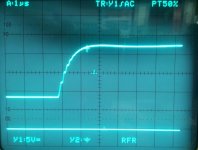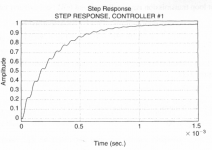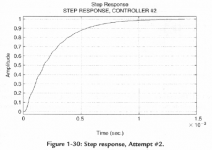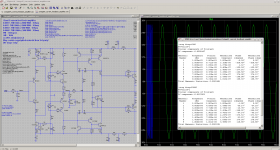Myth destroyed: Ringing on rising and falling
Have found some interesting facts behind the mystery from upper post. The gain margin of the amplifier was a bit low at that time of development. I have simulated the old asc file and found 7.5 db gain margin corresponding to the oscilloscope screen shot. Attached you can find two graphs from p24/p25 of the book "Analog Circuits / World Class Design" from Robert A. Pease which shows the same "wiggles" at about 7 db gain margin and no "wiggles" at > 10db gain margin.
As you know I have changed the base stopper resistors of the power bjt's from 4.7R to 18R which changed the gain margin from 7.5db to > 10db.
What do you say?
Amp is stable and working fine with TMC. There is only one thing where I can't find the reason why there is this sort of ringing on rising and falling edge. Frequency is about 5-6 MHz.
Anyone has seen this before? Any Ideas where to start "debugging".
Simulation with square root shows some small signs of the same effect...
Have found some interesting facts behind the mystery from upper post. The gain margin of the amplifier was a bit low at that time of development. I have simulated the old asc file and found 7.5 db gain margin corresponding to the oscilloscope screen shot. Attached you can find two graphs from p24/p25 of the book "Analog Circuits / World Class Design" from Robert A. Pease which shows the same "wiggles" at about 7 db gain margin and no "wiggles" at > 10db gain margin.
As you know I have changed the base stopper resistors of the power bjt's from 4.7R to 18R which changed the gain margin from 7.5db to > 10db.
What do you say?
Attachments
Have found some interesting facts behind the mystery from upper post. The gain margin of the amplifier was a bit low at that time of development. I have simulated the old asc file and found 7.5 db gain margin corresponding to the oscilloscope screen shot. Attached you can find two graphs from p24/p25 of the book "Analog Circuits / World Class Design" from Robert A. Pease which shows the same "wiggles" at about 7 db gain margin and no "wiggles" at > 10db gain margin.
As you know I have changed the base stopper resistors of the power bjt's from 4.7R to 18R which changed the gain margin from 7.5db to > 10db.
What do you say?
I say that this is something that's important to remember for the future, and thank you for bringing it to our attention. Many know that low phase margin will cause overshoot and ringing in a step response, it's handy to also know that low gain margin can cause these "wobbles" in the rising edge of the step response.
...
it's handy to also know that low gain margin can cause these "wobbles" in the rising edge of the step response.
Dear Harry,
thx. I also thought 6db gain margin is enough to get a stable system. Btw. both graphs from Pease's book have had a good phase margin of about 85 degrees.
SA2013 amplifier was working stable at those days with those 7.5 gm but a bit nervous working on high power square wave transients...
BR, Toni
Dear Harry,
thx. I also thought 6db gain margin is enough to get a stable system.
Depends what you mean by stable. Strictly speaking, your amp with low gain margin was stable. Yes, there were wobbles on the edges of transients, but the output continued to follow the input and there was no sustained oscillation of any kind.
The desire with amplifiers is to ensure stability under all reasonable operating conditions. When testing transients into resistive loads and overshoots or wobbles are seen, the fear is that the low phase and/or gain margins may mean that potentially "harsher" operating conditions may push the amplifier into full-blown instability. IMHO, "smooth" transient response is not necessary per se for audio power amplifiers.
...
When testing transients into resistive loads and overshoots or wobbles are seen, the fear is that the low phase and/or gain margins may mean that potentially "harsher" operating conditions may push the amplifier into full-blown instability. IMHO, "smooth" transient response is not necessary per se for audio power amplifiers.
Agree! Amplifier should work stable from 0 degree to 40 degree room temperature as well as with every complex speaker loads. Hence we need more headroom also for gain margin.
... facts behind the mystery from upper post. The gain margin of the amplifier was a bit low at that time of development...
What do you say?
I say thank you very much.
Like Harry, I also think smooth RF transient response is probably not necessary in an audio amp with appropriate input filters.
But very useful to learn where to examine to check on the GM.
Also thanks for the reference.
If I had read that then I would have been more cautious when I supported 6 dB as a reasonable GM.
Best
I rebuilt a Crimson stereo CE1704 with quite a few PCB "improvements" and chassis wiring "improvements"
I found the same "wobble" on the rising edge. Although not as bad as your scope pic.
Not tried discussing with Brain Powell yet.
Maybe you have the schematic and would be able to simulate this?
Like Harry, I also think smooth RF transient response is probably not necessary in an audio amp with appropriate input filters.
And output filters, because RF peaking worsens RFI tolerance on the speaker line. It makes the amp a resonator, IE an antenna.
How much nV/rtHz is audible? One of my prototypes gets 100-200nV/rtHz, depending on the feedback divider impedance, and not using current mirrors (don't need them anyway, if you're clever).
Hard to say. SA2013 with a gain of > 30 times has a simulated 124nV/rtHz /(4nV/rtHz input referred).
The real world result: the amplifier is deadly silent also on (horn-) speakers with very high efficiency.
BR, Toni
...and not using current mirrors (don't need them anyway, if you're clever).
Not using a current mirror is not clever. You need it to maximise current transfer between the first stage and the second stage. This in turn maximises the forward path gain of the amplifier. See link below:
http://www.diyaudio.com/forums/soli...age-swings-lenders-circuit-5.html#post3444510
Last edited:
Yes, for a measly 6db gain in performance, if that. There is not much to gain, and when THD is already well below .001%, it's probably wise to try and improve things other than THD.
Completely wrong again.
MikeK, would you like to show us one of YOUR circuits with better than 10ppm THD illustrating the advantages you espouse?Completely wrong again.Depending on circuit details, you get far more than 6dB of gain by using a current mirror for the transadmittance stage.
Something close to 'real life' please though SPICE world will do .. but no perfect voltage followers etc. This would enhance your credibility.
Leave out output networks etc if you feel stability on 'real life' loads is unimportant.
Stuff you've posted in the past has been sadly lacking in both basic performance as well as any semblance to 'real life'
at what end of what?How much nV/rtHz is audible? One of my prototypes gets 100-200nV/rtHz,................
sqrt(20k) = 141 giving noise~141*124nV comes to a speaker input noise of ~17.5uVac (0.0175mVac). I would expect that to be very quiet............with a gain of > 30 times has a simulated 124nV/rtHz /(4nV/rtHz input referred).
The real world result: the amplifier is deadly silent also on (horn-) speakers with very high efficiency...................
Any power amp that can achieve (input referred) 4nV/rootHz must be quiet and your horn speakers prove this to be so.
Last edited:
True, but you can get that gain in other places...
I would be very interested to how you obtain "...that gain in other places..."
A schematic would help.
- Home
- Amplifiers
- Solid State
- 2stageEF high performance class AB power amp / 200W8R / 400W4R



